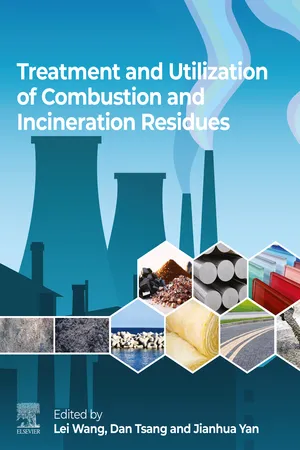
Treatment and Utilization of Combustion and Incineration Residues
- 530 pages
- English
- ePUB (mobile friendly)
- Available on iOS & Android
Treatment and Utilization of Combustion and Incineration Residues
About This Book
Treatment and Utilization of Combustion and Incineration Residues introduces state-of-art strategies for combustion and incineration solid residue management and utilization. The book also reviews current technologies for pollutant removal and control of combustion and incineration residues.
Recycling ashes and slags in sustainable construction materials are also evaluated on environmental impacts and engineering values, and the use of different ashes and slags in cement clinker production is classified based on the sources and properties of the residues. In addition, the recovery of valuable metals and inorganic elements is also discussed. Finally, Treatment and Utilization of Combustion and Incineration Residues examines the latest understanding of reaction mechanisms of various treatment technologies is elaborated to foster the future design of treatment technologies and the actualization of sustainable management for combustion/incineration residues.
- Provides systematical classification and introduction of combustion/incineration solid residues
- Introduces the detoxification and purification technologies of hazardous combustion/incineration ashes and slags
- Highlights the treatment and recycling approaches of combustion and incineration residues in cement clinker production and sustainable construction materials manufacture
- Provides systematical classification and introduction of combustion/incineration solid residues
- Introduces the detoxification and purification technologies of hazardous combustion/incineration ashes and slags
- Highlights the treatment and recycling approaches of combustion and incineration residues in cement clinker production and sustainable construction materials manufacture
Frequently asked questions
Information
Table of contents
- Cover image
- Title page
- Table of Contents
- Copyright
- Contributors
- Part I. Overview of combustion/incineration residues
- Part II. Purification and detoxification of combustion/incineration residues
- Part III. Recycling of combustion/incineration residues into cement clinker
- Part IV. Recycling of combustion/incineration residues into SCMs and aggregates
- Part V. Recycling of combustion/incineration residues into functional materials
- Part VI. Resource recovery from combustion/incineration residues
- Part VII. Future prospects
- Index